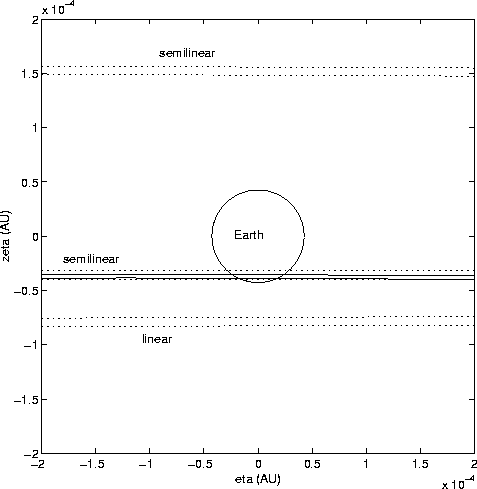The least squares fit using only the 27 observations up to July 6
has an RMS of the residuals of 0.69 arc seconds; we use the weighting
corresponding to 1 arc second for consistency with our approach of
Section 3.1, although in a simulated case the residuals have been
manufactured by some random number generator and they are likely to be
more Gaussian than in any real example. The conditioning number of
the covariance matrix is
![]() ,
with a largest eigenvalue
,
with a largest eigenvalue
![]() ,
thus the confidence ellipsoid is quite
large and we are really testing the boundaries of applicability of our
semilinear method.
,
thus the confidence ellipsoid is quite
large and we are really testing the boundaries of applicability of our
semilinear method.
Propagation of the nominal orbit in the near future reveals close
approaches repeating more or less every 4 years; the first one is
1996, at a minimum distance 0.030 AU; the closest one is on October
3, 2004, at a distance 0.021 AU. The close approach analysis of the
1996 encounter indicates that there is nothing to worry about for that
year. The ![]() linear confidence ellipse on the MTP, centered on
the 0.030 AU nominal closest approach, has semiaxes of 184 km and
0.13 AU, that is the long semiaxis is much longer than the nominal
miss distance. The long axis, however, is in a direction forming an
angle of
linear confidence ellipse on the MTP, centered on
the 0.030 AU nominal closest approach, has semiaxes of 184 km and
0.13 AU, that is the long semiaxis is much longer than the nominal
miss distance. The long axis, however, is in a direction forming an
angle of ![]() with the direction towards the Earth. As a result,
both the linear and the semilinear confidence boundaries on the MTP
come no closer than
with the direction towards the Earth. As a result,
both the linear and the semilinear confidence boundaries on the MTP
come no closer than
![]() AU from the Earth.
AU from the Earth.
 |
The close approach analysis of the 2004 encounter gives a much less
comfortable result. The ![]() linear confidence ellipse on the
MTP, centered on the
dn=0.021 AU nominal closest approach, has
semiaxes of 590 km and 0.19 AU, that is the long axis is again
much longer than the nominal miss distance. The size of the ellipse
would not matter if, as in the previous case, the long axis were
oriented in a safe direction. The worrisome feature is, for the 2004
encounter the ellipse points almost exactly towards the Earth: the
angle between the long axis and the direction to the center of the
Earth is only
linear confidence ellipse on the
MTP, centered on the
dn=0.021 AU nominal closest approach, has
semiaxes of 590 km and 0.19 AU, that is the long axis is again
much longer than the nominal miss distance. The size of the ellipse
would not matter if, as in the previous case, the long axis were
oriented in a safe direction. The worrisome feature is, for the 2004
encounter the ellipse points almost exactly towards the Earth: the
angle between the long axis and the direction to the center of the
Earth is only
![]() .
Nevertheless, the linear confidence
boundary does not touch the Earth surface, missing it by less than one
Earth radius; to check this, it is enough to compute
.
Nevertheless, the linear confidence
boundary does not touch the Earth surface, missing it by less than one
Earth radius; to check this, it is enough to compute
![]() .
.
The nonlinearity of the map onto the MTP is impressive, as shown in Figure 9: the linear and the semilinear boundary are close only in the immediate neighbourhood of the nominal solution, everywhere else they develop in a qualitatively different way; the range of closest approach distances is completely different (note the different scales on the two axes). Looking at an enlarged view (Figure 10) we see that the semilinear boundary intersects the Earth surface, while the linear ellipse does not, as predicted by the simple calculation performed above. In this particular case, the linear confidence analysis with the observations up to July 6 would lead to exclude the possibility of a collision which, in the simulation, actually takes place. The semilinear analysis would correctly conclude that an impact cannot be excluded.
 |